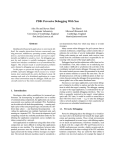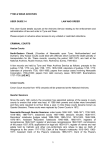Download Nottingham's borough court rolls: a user's guide by Richard Goddard
Transcript
1 Nottingham’s borough court rolls: a user’s guide* by Richard Goddard Nottingham’s medieval borough court rolls of the fourteenth and fifteenth centuries are a valuable source for those interested in Nottingham and its region in the later middle ages and for medieval urban historians more generally. Indeed, as can be seen from the further reading below, they might also be considered the principal source for the history of the medieval town. Extant long running medieval borough court rolls, like those for Nottingham, are rare.1 The court rolls which are calendared here are housed in the Nottinghamshire Archives Office, CA 1251a-1341 with the file names used in this web-based calendar reflecting their Nottinghamshire Archives Office catalogue number and the date covered by each roll. They were calendared as a joint research project of the University of Nottingham Institute for Medieval Studies (now Institute for Medieval Research) and Nottingham City Council with a grant from the Leverhulme Trust. The aim of the project was to produce an edition of the extant medieval rolls in a calendared form in English to make the text available to a wider range of users.2 The rolls were transcribed, translated from Latin into English and calendared by Dr Trevor Foulds (project leader) and Dr J. B. Hughes. As can be seen from the sheer volume of material presented in the electronic calendar below, this was a monumental and complicated task that was completed with great skill and editorial sensitivity. Until 1457 each annual roll comprises up to twenty-six parchment membranes. Some of the court rolls are in excellent order, whilst others have suffered so severely from damp that they can only be * My thanks to Dr Judith Mills for her assistance and advice in compiling this introduction. 1 Similar survivals can be found in Exeter (Devon Record Office MCR/), Chester (Chester Record Office Z/SR/; Z/MFR/) and Winchester (Hampshire Record Office W/D1/). 2 Trevor Foulds, J. Hughes and M. Jones, ‘The Nottingham Borough Court Rolls: The reign of Henry VI (1422– 57)’, Transactions of the Thoroton Society, 97, (1993), 74. 2 unrolled and read with great difficulty. The overwhelming size of the resulting calendar meant that traditional paper publication was impossible and so, after lying unused and neglected for a number of years, Dr Foulds graciously allowed the calendar to be made available electronically hosted by the Centre for Urban Culture at the University of Nottingham. In this way the original aims of the project were finally realised. NOTTINGHAM’S BOROUGH COURT W. H. Stevenson’s 1882 edition of selected extracts from Nottingham’s borough documents was the first to highlight the potential of the borough court rolls.3 Indeed Stevenson’s seminal scholastic contribution to the history of Nottingham remains largely unchallenged a hundred and thirty years after the publication of his edition.4 This towering presence might explain why relatively little research, until recently, has been undertaken on medieval Nottingham when compared to other towns such as Norwich, Bristol, or Coventry. Stevenson’s thorough acquaintance with the borough records meant he was the first to write in detail about the town’s borough court.5 Nottingham’s borough court was a venue for dispute settlement and arbitration between burgesses. Serious offences, such as murder, theft and treason were dealt with either by coroners or superior royal circuit courts; lesser public order jurisdiction or breaches of national legislation such as the Assize of Bread and Ale were devolved from the crown to the local leet or frankpledge courts which, in these cases, acted as the crown’s representative.6 3 Stevenson, W. H. (ed.), Records of the Borough of Nottingham, vol. 1 (Nottingham, 1882). 4 For a resent reassessment of Stevenson’s contribution to Nottingham’s history see, Judith Mills, ‘Stevenson revisited: a fresh look at Nottingham’s borough records, 1400-1600’, Transactions of the Thoroton Society, 113 (2009), 55-72. 5 Stevenson, Records of the Borough of Nottingham, vol. 1, pp. ix-x. 6 F. J. C. Hearnshaw, Leet Jurisdiction in England (Southampton, 1908); F. Pollock and F. W.Maitland, The history of English law (Cambridge, 1968), 560-71. 3 Whilst in some towns leet and borough courts were amalgamated this does not seem to have been the case in Nottingham. The borough court was held in Nottingham’s Guild Hall, located close to the Weekday Market and on the boundary between the French and English boroughs. Nottingham’s Charter of Incorporation granted in 1449 gave the burgesses the right to hold a Court in the Guild Hall to hear plaints of debt, breach of covenant, trespass and other offenses, and this is considered to be a simple confirmation of existing practice for the Borough Court.7 The court was held every fortnight, usually on alternate Wednesdays, before the mayor and bailiffs or their deputies in a system that attempted to mirror that of the courts of Westminster. The fullest annual rolls generally run from the first court held on or around Michaelmas (29th September) until the final court of the year held on or around the feast of the Exultation of the Holy Cross (14th September) in the following calendar year. The dates in the rolls are written as regnal rather than calendar years. Thus the 3rd October 1375 is written in the rolls as ‘The court held on Wednesday after Michaelmas in the forty-ninth year of the reign of King Edward the Third after the Conquest’.8 Occasionally an additional Pie Powder court (Curia Placitorum Pipouderorum) was held. This was a distinct merchant court that sat during the town’s fairs and markets as a venue for settling market disputes in between the regular borough court sessions. The borough court dealt with all sorts of civil actions. These included personal suits between individuals (usually to the value of 40s.),9 as well as pleas relating to real property and the enrolment of charters. It was presided over by the mayor and his bailiffs, who were the leading members of the urban community. Lesser court officials supervised the levying of 7 Stevenson, Records of the Borough of Nottingham, vol. 2, 194-95. 8 For the conversion of saints’ days and regnal years to calendar years, see C. R. Cheney and Michael Jones (eds), A handbook of dates for students of British history (Cambridge, 2000). 9 J. S. Beckerman, ‘The Forty Shilling Jurisdictional Limit in Medieval English Personal Actions, in D. Jenkins (ed.), Legal History Studies 1972 (Cardiff, 1975), 110-17. 4 amercements and fines. These officials, along with the juries of presentment and inquisition, were chosen from the middle-ranking members of the urban community, usually those some experience of Nottingham’s legal processes. Many of the early rolls consist of actions for assault, defamation and trespass (commonly divided between non-violent and violent offences).10 The most common personal action was for debt.11 Pleas between the town’s inhabitants were entered upon the rolls (identified here as ‘Burgess Pleas’) and separate rolls were kept for the pleas between strangers, or where an outsider was in dispute with a Nottingham citizen (Rotulus Placitorum Forinsecorum, identified here as ‘Foreign Pleas’). As Stevenson observed, whilst the fourteenth-century rolls are very full, generally those of the fifteenth century are less detailed. By the end of the series, in the mid-fifteenth century, the rolls survive less well and are significantly more fragmented. Stevenson correctly identified that ‘the variation in the way of keeping these rolls is generally identical with a change of hand, so that the meagreness or fullness of the entries may be explained by the apathy or zeal of the clerk that kept them.’12 There is also an increase in the number of foreign pleas in the later rolls (with a corresponding diminution the number of burgess pleas). After 1457, no further court rolls survive until 1481 at which time the method of court record keeping had changed and, instead of rolls of parchment, these later, rather carelessly recorded court proceedings, are entered in paper books.13 These have not been calendared here. PROCEDURE 10 For a recent analysis of trespass litigation see, Philipp R. Schofield, ‘Trespass litigation in the manor court in the late-thirteenth and early-fourteenth centuries’ in R. Goddard, J. Langdon and M. Müller (eds), Survival and Discord in Medieval Society: essays in honour of Christopher Dyer (Turnhout, 2010), 145-60. 11 For debt in the Nottingham borough court rolls, see Richard Goddard, ‘Surviving recession: English borough courts and commercial contraction 1350–1500’ in Goddard, et al., Survival and Discord, 69-87. 12 Stevenson, Records of the Borough of Nottingham, vol. 2, p. ix. 13 CA 1370-2. 5 The law practiced in the borough court was analogous to manorial courts found in rural communities.14 Most of the court’s business concerned personal pleas where one individual sued another in a private civil action. The court’s procedures remained broadly similar for all types of personal plaint. The procedures followed in these disputes can be seen most clearly in pleas concerning debt which were instigated as a result of a default. Most goods in this period were paid for partly with a cash down payment and part with credit. An arrangement was made (though rarely written down for the small amounts pleaded here) whereby the borrower would pay back the outstanding amount (usually with interest, although because of the proscription against usury this is never acknowledged) on an agreed date in cash. Once a borrower had failed to repay the money he or she owed, the creditor would instigate an action in the court, by formally stating his case. A suit was begun by the plaintiff informing a court official of his wish to sue and providing the basic details of the action. These were recorded on the court rolls as New Pleas. The plaintiff was usually required to produce two pledges, local people who accepted the responsibly of ensuring that those involved in the case responded to the court’s instructions. In theory both parties were required to be present, or be legally represented, in court in order to proceed with the suit. Thus in October 1429, the London merchant Thomas Tycchill through his attorney, John Ewer, informed the court at Nottingham that John Abbot of Bingham (Nottinghamshire) had bought, on 30th June 1428, half dozen linen cloths and a half dozen linen kerchiefs worth 26s. 8d. The credit for these goods had been extended to John Abbot until 13th November 1428, but he had paid nothing.15 Tycchill claimed damages of 13s. 4d. 14 For the working of manorial courts, see M. Bailey (ed.), The English Manor c.1200-c.1500 (Manchester, 2002), 167-92; Chris Briggs, Credit and village society in fourteenth-century England (Oxford, 2009), 13-14. 15 CA 1321/II fol. 2. 6 It was common however, for the accused, perhaps unsurprisingly, to not turn up. In most courts a defendant was entitled to be called to court three times before he was attached. Attachment in these cases rarely meant arrest, suggesting some reticence in ordering the imprisonment of one’s fellow burgesses, and commonly defendants were attached by the seizure of some of their personal property in order to encourage attendance. Further delays were allowed by ‘essoins’ - reasonable grounds for non attendance. The court rolls are full of repeated essoins. In Nottingham, a weary clerk, having lost count of the number of times a dilatory defendant called John Shelford had failed to appear, simply wrote ‘many defaults’ against his name.16 Non-attendance did not cause any loss to the court because every essoin, whether reasonable or not, resulted in a fine, usually 3d., that went to the court. The court then attempted to enforce the defendant’s appearance in court so that the claim against them could be answered, by appointing pledges who could guarantee to bring the defendant to court. In the Tycchill v. Abbot case these pledges were John Cost and Adam West, local men who were well known to Nottingham’s court officials and who regularly acted as pledges there. If that failed the court had the right to impound the defendant’s, in this case John Abbot’s, goods when they lay within the court’s jurisdiction. They also could fine both the defendant and the pledges for non attendance. Beyond non attendance, there were other ways of delaying the suit in what resembled a game of legal chess.17 At every subsequent session of the borough court report was made of the progress of each case and if necessary further orders were issued with the aim of advancing the suit through the court. Once the defendant appeared in court there were a number of options open to each of the parties and the court officials. Permission could be obtained for an out-ofcourt-settlement known as a ‘licence to agree’. Another option was arbitration. In the 16 CA 1305 fol. 8. These are very common. 17 The most comprehensive examination of the legal processes used in borough courts, see Mary Bateson (ed.), Borough Customs, vol. 1 (Selden Society, 18, London, 1904), 170-85, 198-201. 7 fourteenth century ‘love days’ were commonly found in Nottingham’s court rolls. An example from Nottingham is the case of Walter le Gerther who had bought two stocks of timber for 4s. 6d. on credit from John Prest but had subsequently refused to pay for them. After a number of court appearances and delays, a love day was granted between the two men (presumably with a court-appointed arbitrator) so that they could sort it out.18 More commonly the case was pleaded in which case the defendant formally answered the claim in open court, either admitting the charge or denying it. Thus in the Tycchill v. Abbot case, the defendant answered the complaint, in this case through an attorney, Nicholas Barbour, claiming that he, John Abbot, owed nothing to Thomas Tycchill. An inquisition was ordered by the court. Defendants in borough court suits were often required to wager at law – that is, find a given number of witnesses who could vouch on oath that the defendant was innocent, known as ‘compurgation’. The number of compurgators was generally specified by the court. Thus in 1399, William de Bridgford was required to defend himself ‘ten-handed’ in a plea of debt, that is get nine other people to swear to his innocence.19 These were to be men of good character who were required to swear to William’s good reputation and their belief in his word, as much as to the facts of the case. In an age where the spiritual consequences of lying on oath were considered grave, this was considered sufficient. On the oaths of these compurgators the case could be won or lost. The reputation, and thus creditworthiness, of members of Nottingham’s business community was very important because many debt agreements were made orally and doubts about a person’s creditworthiness could be communicated very rapidly. John Shelford of Nottingham frequently failed to repay his debts and it was this reputation that probably contributed to him losing his case against William 18 CA 1263 fol. 10d; CA 1263 fol. 8. 19 CA 1297 fol. 15. 8 Mysterton over 5s.-worth of barley in 1410.20 Debtors often failed in their cases because, when they went to law, they could not find sufficient number of compurgators to act as character witnesses to support their version of events. If they did find enough witnesses to attest to their truthfulness, it was their opponents, the plaintiffs, who were judged to have brought a false claim and thus lost the case. In William de Bridgford’s case his accuser, called John, did not attend this ‘wager at law’ at the borough court, presumably because he thought the compurgators would support de Bridgford, and so he withdrew his case. The defendants, plaintiffs and their attorneys moved their pieces around the metaphorical chess board of the borough court strategically by choosing various paths through the court. One of these choices, when a plea was contested, was trial by jury. Juries were empanelled by the court and their role (unlike modern juries) was to collect and present evidence to the court and decide whether the accused was guilty or not. The court records regularly demonstrate that jurors failed to attend when summoned, thus delaying the case and the ultimate resolution of the dispute. In the case of barrel maker, William de Lenton, who sued Henry Meignell for 18s. for a horse that he should have paid for in 1375,21 Meignell, though his attorney claimed that he owed nothing. An inquisition was ordered and the jury reported back that Meignell did owe the 18s. The court then ordered that de Lenton should recover the money from Meignell and was awarded a further 2s. in damages also to be paid by Meignell. Meignell is described in the record as being amerced or ‘in mercy’, that is fined. The court also generally undertook to enforce the repayment. If the defendant did not pay up immediately, this was usually undertaken through the seizure of the defendant’s goods by the court. If, on the other hand, the jury ruled that the defendant had done no wrong then he was exonerated and the plaintiff was amerced, presumably for wasting the court’s time by bring an unwarranted action. 20 CA 1305 fol. 20d. 21 CA 1279 fol. 5d. 9 When the system worked, it worked well. It was a highly effective and relatively cheap way for plaintiffs to settle their disputes quickly. Borough courts cases were generally concluded more quickly than at other courts such as the Court of Common Pleas in Westminster. Most cases were completed within eight to twelve weeks, usually within two court sittings. The four-penny cost of making a plaint was also not a great sacrifice, even for a small debt and fines were rarely more than 3d. To take the entire suit all the way to judgement in a borough court could cost as much as £3, which might represent a considerable investment for the recovery of a debt of a couple of shillings. USING NOTTINGHAM’S BOROUGH COURT RECORDS The records of Nottingham’s borough court can be used to investigate multifarious aspects of Nottingham in the fourteenth and fifteenth centuries. From identifying and analysing the careers of those engaged in administering Nottingham’s medieval, and often unruly, population – mayors, bailiffs, affeerers (who decided on fines and damages), appraisers (who valued goods taken in lieu when the guilty party was unable to pay in cash), and jurors,22 the court’s effectiveness and the processes that the court employed – as seen for example in 1447 court entry whereby John Lovot, at over seventy year old, was considered too elderly to continue to serve on juries in Nottingham.23 They can be used to examine dispute settlement in the middle ages, explore the varied trades, markets and industries of the medieval town and the town’s economic and migration hinterlands, kinship and business networks, family histories, topographical and buildings research (street names and building details are often cited), to understanding about how medieval people worked and spent their leisure time (gaming, prostitution and particularly ale drinking are regularly mentioned), and how 22 Judith Mills, ‘Continuity and change: Nottingham 1400-1600’ (Unpublished PhD Thesis, University of Nottingham, 2010), 208-10. 23 CA 1336/I, fol. 3 . 10 peaceful neighbourly relations were maintained (often unsuccessfully) and about urban social hierarchies and a myriad other fascinating topics. Many tantalizing discoveries can be made from within the rich vein of these rolls. The further reading suggested below demonstrates some of the uses to which these borough court records have been recently put. A brief example will demonstrate some of their potential. In 1353, Roger Shoghull accused Elias of Widmerpool in a plea of trespass with bloodshed claiming that in December of 1352 in Barker Gate, Widmerpool, with others, assaulted Shoghull so that he despaired for his life. Shoghull claimed damages of £20. Widmerpool came to the court and defended himself, saying that he was not guilty. An inquiry was ordered by the court and an inquisition jury was assembled to investigate the claim and report back at the next court.24 Whilst unfortunately we don’t know how this case ended – possibly either due to the roll being badly stained or the death of one or both of the parties – the court records allow us to get something of a feel for the people involved, particularly Roger Shoghull. Shoghull made frequent appearances in court in the early 1350s both as plaintiff and defendant.25 Roger Shoghull and other members of his family, John and Henry, sued each other, and others, regularly for debt and trespass in 1352. Indeed in October of that year Henry Shoghull and his wife Alice and Roger Shoghull and his wife Joan got into a violent fight that resulted in blood being spilled (probably over a debt), a brawl which resulted in further court appearances for the two of them. Interestingly whilst the family regularly turned up in court to accuse each other, they were more reticent when appearing to answer the charges. In many of their pleas the defendant is noted by the court scribe as ‘does not come’ and the case was carried over to the next court. However, the Shoghulls should not be seen simply as violent Nottingham undesirables who, in the twenty-first century, would be served with an ASBO. It is clear for 24 CA 1264f fol. 7. 25 CA 1264 fol. 2d, 3, 6d, 11, 11d, 14, 15, 18d, 22d. 11 example that they were businessmen who regularly sued dilatory customers (and were sued by other local business people) in an attempt to recover late payments using the borough court’s debt suit. Further the mere fact that they used the court to settle their disputes, even their family quarrels, suggests a great reverence for the law and a belief in the effectiveness of the justice dispensed by the borough court and its officers. This is seen particularly by John Shoghull, who regularly acted as a court-appointed pledge in the same period. As already noted, his role here was to ensure that the defendant would either turn up to the next court or pay his fine at the conclusion of the case. Furthermore, if the defendant failed in this it was the pledge, John Shoghull, who was required to pay in the defendant’s stead, suggesting he was a man of standing within the community. It may also have been possible that he was just perceived as a man with family connections who could ensure the defendants’ compliance. The court was an instrument of dispute resolution. Thus in the dispute between Roger Shoghull and Thomas le Eyr, wherein Shoghull sued le Eyr for attacking him, again resulting in bloodshed, the two of them asked the court for a ‘love day’ whereby the dispute might be settled out of court. When the fact that all these pleas took place within the space of just twelve months is combined with the fact that the Shoghull family seem wholly typical in a medieval context, it might suggest that medieval Nottingham was a violent place. However, modern users of the court rolls might need to exercise some restraint and caution and refrain from leaping to ahistorical conclusions. Medieval urban society was a complex, multilayered, diverse, cosmopolitan arena wherein the motives and actions of its citizens often are concealed beneath a formulaic judicial rhetoric. FURTHER READING This brief bibliography identifies recent work that has utilised the Nottingham borough court rolls as well as earlier selected edited extracts from the rolls (Stevenson) and two essays that 12 supply some background reading on medieval Nottingham (Foulds and Marcombe in the Centenary History). This is intended as a guide to further reading rather than an exhaustive list. Casson, C., ‘A Comparative Study of Prosecutions for Forgery in Trade and Manufacturing in Six English Towns, 1250–1400’, Unpublished PhD Thesis, University of York (2009) Foulds, Trevor, J. Hughes and M. Jones, ‘The Nottingham Borough Court Rolls: The reign of Henry VI (1422–57)’, Transactions of the Thoroton Society, 97, (1993), 74–87 Foulds, Trevor, ‘Trade and Manufacture’ in John Beckett (ed), A Centenary History of Nottingham (Chichester, 2006), 72-83 Goddard, Richard, ‘Surviving recession: English borough courts and commercial contraction 1350–1500’ in R. Goddard, J. Langdon and M. Müller (eds), Survival and Discord in Medieval Society: essays in honour of Christopher Dyer (Turnhout, 2010), 69-87 Mills, Judith, ‘Continuity and change: Nottingham 1400-1600’ (Unpublished PhD Thesis, University of Nottingham, 2010) Mills, Judith, ‘Stevenson revisited: a fresh look at Nottingham’s borough records, 14001600’, Transactions of the Thoroton Society, 113 (2009), 55-72 Marcombe, David, ‘The medieval town’ in John Beckett (ed), A Centenary History of Nottingham (Chichester, 2006), 84-106 Stevenson, W. H., (ed.), Records of the borough of Nottingham, vols 1-2 (Nottingham, 18823) COMMON ABBREVIATIONS USED IN THE CALENDAR <3d.> = a marginal note referring to the fine or amercement 13 Amor = love day aff = affeerer def = defendant Dis = districcio or distringantur (distrained) Inq = inquisition M = misericordia (in mercy) pl = plaintiff Plgs pros = pledges























